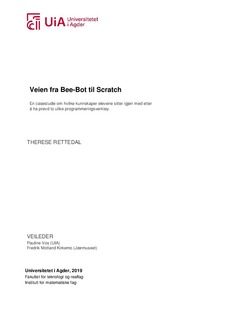| dc.contributor.author | Rettedal, Therese | |
| dc.date.accessioned | 2019-10-23T07:27:09Z | |
| dc.date.available | 2019-10-23T07:27:09Z | |
| dc.date.issued | 2019 | |
| dc.identifier.uri | http://hdl.handle.net/11250/2623832 | |
| dc.description | Masteroppgave matematikkdidaktikk MA502 – Universitetet i Agder 2019 | nb_NO |
| dc.description.abstract | The way from Bee-Bot to Scratchis a case study that looks at what competencies the pupilsmanage to pass from anobject programminglanuageto a computer-based programming language.Because programming comes under the core elements of mathematics in the new curriculum that is initiated in the autumn of 2020, I have chosen this research question: "Can the pupils' programming knowledgefrom Bee-Bot be transferred to Scratch in a mathematics session,focusing on computational thinkingand creativity?" The study therefore focusesat howmuch of the various topicsemerge and which competences the pupils manage to pass on from the programming language Bee-Bot to Scratch.In this study I have used a qualitative method. The data is retrieved using classroom observations with field notes and audio recordings. Through the data collection I have been a participating observer where the purpose has been to see how the students work with the programming in collaboration with their fellow students.Becauseprogramming is a relatively new topic intheNorwegian school, there is limitedNorwegian research on the topic. The theoretical framework that the thesis has taken into account is Wing (2006) on “computational thinking” and Niss (2003) “eight competencies for what good mathematical competence is”, while also focusing on what the government's new curriculum says about what mathematics should contain.The findings of this study show that by startingwithprogramming in the form of a concreting tool such as Bee-Bot, the students get an easy transition to how programming works and the transition to Scratch can be seen as a kind of next level in programming. In the analysis of the findings, it also emerges that there are several equalmathematical topics appearing in both programming languages. The findings also show that working with programming with these programming languages allows students to be curious, explore, inspire, argue and collaborate with each other. | nb_NO |
| dc.language.iso | nob | nb_NO |
| dc.publisher | Universitetet i Agder ; University of Agder | nb_NO |
| dc.rights | Attribution-NonCommercial-NoDerivatives 4.0 Internasjonal | * |
| dc.rights.uri | http://creativecommons.org/licenses/by-nc-nd/4.0/deed.no | * |
| dc.subject | MA502 | nb_NO |
| dc.title | Veien fra Bee-Bot til Scratch : En casestudie om hvilke kunnskaper elevene sitter igjen med etter å ha prøvd to ulike programmeringsverktøy | nb_NO |
| dc.type | Master thesis | nb_NO |
| dc.subject.nsi | VDP::Samfunnsvitenskap: 200::Pedagogiske fag: 280::Fagdidaktikk: 283 | nb_NO |
| dc.subject.nsi | VDP::Matematikk og Naturvitenskap: 400::Informasjons- og kommunikasjonsvitenskap: 420::Teoretisk databehandling, programmeringsspråk og -teori: 421 | nb_NO |
| dc.source.pagenumber | 92 s. | nb_NO |

